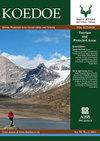Plant community diversity in the Chobe Enclave, Botswana: Insights for functional habitat heterogeneity for herbivores
IF 1.1
4区 环境科学与生态学
Q3 BIODIVERSITY CONSERVATION
引用次数: 5
Abstract
Precise vegetation descriptions and maps are essential tools for the management of natural areas, as well as for understanding animal habitat use. The Chobe Enclave (CE), adjacent to the Chobe National Park and the Chobe Forest Reserve, forms a critical dry season range for many large herbivores. As a tool for future management and studies about wildlife habitat use and migration, this study proposed to describe the plant communities in the CE and to study their relationships with microtopography and soils. Plant species were inventoried in 82 sampling plots (40 x 20 m), covering the vegetation diversity recognised by an unsupervised classification (Landsat images, 30-m resolution). A hierarchical clustering classified the inventories in eight plant communities, mapped with a supervised classification. This study was conducted in parallel with a soil study. Soil variations and degree of flooding largely determine community composition. Floodplains along the Linyanti River and dambos (concentrating local run off from rainfall) provide reliable green forage for wildlife during the dry season. Adjacent to floodplains, riverine forests also maintain green browse and grazing well into the dry season. In drylands, vegetation is largely determined by soil texture. Forests dominated by Baikiaea plurijuga occupy the acidic, red sands in the east, while sandveld vegetation grows on deep sands in paleo-river channels. These habitats support dominant grasses, which provide important forage for grazers during the wet season. Finally, woodlands dominated by Colophospermum mopane, characterised by sodium-rich and alkaline soils, enable herbivores to meet their mineral requirements during reproduction. Conservation implications: Our soil and vegetation studies provide important insights into factors determining plant communities. Their diversity and close vicinity play a critical role in enabling herbivores to adapt to seasonal variations in forage quantity and quality. Results will enable researchers to gain insights into animal habitat seasonal use in the Chobe Enclave.博茨瓦纳乔贝飞地的植物群落多样性:对食草动物功能栖息地异质性的见解
精确的植被描述和地图是自然区域管理的重要工具,也是了解动物栖息地使用情况的重要工具。乔贝飞地(CE)毗邻乔贝国家公园和乔贝森林保护区,为许多大型食草动物形成了一个关键的旱季范围。为了更好地管理和研究野生动物栖息地的利用和迁移,本研究提出了对东部地区植物群落的描述,并研究它们与微地形和土壤的关系。在82个采样样地(40 x 20 m)中调查了植物物种,覆盖了通过无监督分类识别的植被多样性(Landsat图像,30 m分辨率)。采用分层聚类方法对8个植物群落进行了分类,并绘制了监督分类图。这项研究与一项土壤研究同时进行。土壤变化和洪涝程度在很大程度上决定了群落组成。林燕提河沿岸的洪泛平原和丹博斯(集中了当地的雨水径流)在旱季为野生动物提供了可靠的绿色饲料。与洪泛平原相邻的河流森林在旱季也能保持良好的绿色植被和放牧。在旱地,植被很大程度上取决于土壤质地。东部以白桦为主的森林占据了酸性的红色沙地,而沙土植被生长在古河道的深沙上。这些栖息地支持优势草,这些草在雨季为食草动物提供重要的饲料。最后,以绿磷菊(Colophospermum mopane)为主的林地,具有富钠碱性土壤的特点,能够满足草食动物繁殖过程中对矿物质的需求。保护意义:我们的土壤和植被研究为决定植物群落的因素提供了重要的见解。它们的多样性和邻近性在使草食动物适应牧草数量和质量的季节性变化方面发挥了关键作用。研究结果将使研究人员能够深入了解乔贝飞地动物栖息地的季节性使用情况。
本文章由计算机程序翻译,如有差异,请以英文原文为准。
求助全文
约1分钟内获得全文
求助全文
来源期刊

Koedoe
BIODIVERSITY CONSERVATION-
CiteScore
3.30
自引率
0.00%
发文量
10
审稿时长
20 weeks
期刊介绍:
Koedoe, with the subtitle ''African Protected Area Conservation and Science'', promotes and contributes to the scientific (biological) and environmental (ecological and biodiversity) conservation practices of Africa by defining the key disciplines that will ensure the existence of a wide variety of plant and animal species in their natural environments (biological diversity) in Africa.
 求助内容:
求助内容: 应助结果提醒方式:
应助结果提醒方式:


